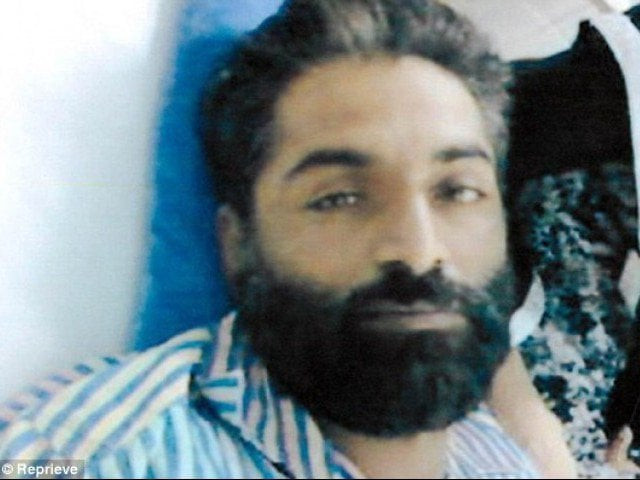Hanging of paralysed convict stayed in Lahore
Judicial Project Pakistan's spokesperson says jail authorities postponed Abdul Basit's death warrants

PHOTO COURTESY: REPRIEVE
Abdul Basit, 43, who was convicted of murder in 2009, contracted tubercular meningitis in 2010 while in prison which left him paralysed from the waist down, according to rights groups and jail officials.
Basit was due to be hanged on Tuesday, but a court delayed the execution after Justice Project Pakistan, the human rights law firm handling his case, raised concerns about how the wheelchair-bound man would mount the scaffold.
"Jail authorities postponed Basit’s death warrants," Yasir Shehzad, spokesperson of the Judicial Project Pakistan, told The Express Tribune.
Another jail official, who requested anonymity, said: "The rules are silent on the hanging of a disabled person. It doesn't explain how to execute a prisoner who can't stand on his legs.
"The hanging has been delayed for the time-being and a new date would be fixed after taking advice from the senior officials."
Basit’s lawyer told Reuters, prison rules did not make it clear how they should proceed with his hanging.
Basit was to have been hanged in Faisalabad in the morning, but authorities were stymied at the last minute because he could not walk to the gallows as required by the jail manual.
"When the judicial magistrate came to the hanging, these guys tried to make him (Basit) stand at the gallows ... it wasn't possible, so the magistrate postponed the hanging," said Wassam Waheed, a spokesperson for legal aid group Justice Project Pakistan.
Basit's mother Nusrat Perveen also confirmed the execution delay, telling AFP that a jail official had called her to inform her "the hanging has been postponed because of Basit's sickness".
"Why do they want his execution? He is already severely sick, what will they get from his hanging?" she added.
On Monday, a three-judge bench had ordered jail authorities not to violate any law during Basit’s hanging which was scheduled for September 22.
Read: ‘Paralysed convict’s hanging is a cruel, peculiar punishment’
A Faisalabad sessions court had authorised prison authorities to hang Basit, who was incarcerated for six years after being convicted of murdering the brother of a lawyer despite his mercy petition pending with the president.
While in prison, Basit had contracted meningitis and the illness had left him bedridden, according to a medical board's report.
As per Pakistan’s prison guidelines, a prisoner must stand on the gallows in order to be hanged and authorities have not explained how they intend to go about hanging a wheelchair-bound convict.
“Pakistan Prison Rules state that the rope for hanging must be the correct length, in order to avoid prisoners facing protracted strangulation (if it is too long) or decapitation (if it is too short)," Project Director for Justice Project Pakistan, Sarah Bilal said.
Read: Disabled murder convict to be hanged from his wheelchair
She added that "The rules state that the rope’s length is determined by measuring it from the lower jaw of the condemned prisoner as he stands on the scaffold. This and other procedures set out in the rules cannot be followed in Basit’s case, leaving open the possibility of a botched hanging."
Basit's hanging was earlier stayed by the Lahore High Court, but it ruled earlier this month that prison authorities could proceed with the execution without making it clear how the hanging would take place.
Pakistan’s obligations under international law “should be kept aside," the court added. However, The Pakistan Prison Rules do not cover guidelines for the hanging of a man paralysed from the waist down.
Read: Prison officials miss court deadline to explain hanging of disabled man
The Human Rights Commission of Pakistan (HRCP) and several other human rights organisations have expressed outrage over the planned hanging and the HRCP had earlier called on the president to stay the hanging and grant him reprieve.
Further, campaigners are trying to get the execution stopped because it involves risks, whereas the authorities seem pre-occupied over thinking how to carry out the execution.



















COMMENTS
Comments are moderated and generally will be posted if they are on-topic and not abusive.
For more information, please see our Comments FAQ